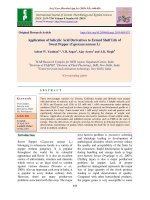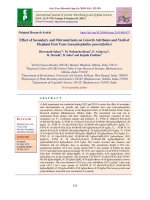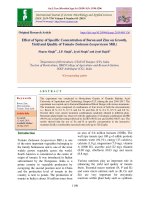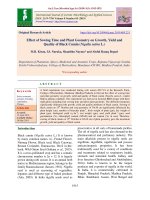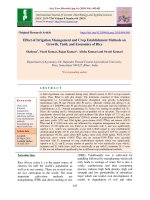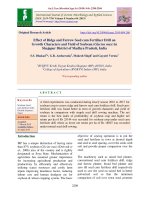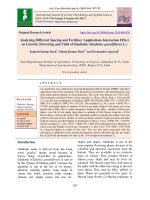Effect of plasma treatment on growth parameters and seed quality of bell pepper (Capsicum annuum L.) under field conditions
Bạn đang xem bản rút gọn của tài liệu. Xem và tải ngay bản đầy đủ của tài liệu tại đây (127.18 KB, 7 trang )
Int.J.Curr.Microbiol.App.Sci (2018) 7(9): 745-751
International Journal of Current Microbiology and Applied Sciences
ISSN: 2319-7706 Volume 7 Number 09 (2018)
Journal homepage:
Original Research Article
/>
Effect of Plasma Treatment on Growth Parameters and Seed Quality of Bell
Pepper (Capsicum annuum L.) under Field Conditions
Cherry Nalwa1*, Ashok K. Thakur1 and Amit Vikram2
1
Department of Seed Science and Technology, 2Department of Vegetable Science, Dr Y. S.
Parmar University of horticulture and Forestry, Solan 173230, Himachal Pradesh, India
*Corresponding author
ABSTRACT
Keywords
Bell pepper, Seed,
Cold plasma,
Osmopriming,
Wettability
Article Info
Accepted:
06 August 2018
Available Online:
10 September 2018
This study investigated the effect of cold plasma treatment on growth, fruit and seed
parameters of bell pepper (Capsicum annuum L.) cultivar California Wonder. The seeds
were exposed to various durations of oxygen cold plasma treatment using glow discharge
technique at FCIPT, Institute for Plasma Research, Gandhinagar, Gujarat, India. The seeds
were pre-treated with power of 100 W for treatment durations of 0, 3, 6, 9, 12, 15 minutes.
The changes in surface morphology of plasma treated seeds were studied by Scanning
Electron Microscopy (SEM) and Contact Angle Goniometer. The treatments comprised of
primed and non-primed seeds and seven seed plasma treatments. Along with plasma
treatment, seeds were also treated with standard osmopriming method for comparison. The
plasma treatment alone as well as in combination with osmopriming up to 6 minutes
plasma treatment was found superior over all treatments in terms of growth, fruit and seed
yield characters. Osmoprimed seeds exposed with 6 minutes plasma were also found to be
best treatment for most of the traits recording plant height 30 DAT (18.97 cm), days to
first mature fruit picking (75.33), number of fruits per fruit (17), fruit yield per plant (1.00
kg), Number of seeds per fruit (190 g) and thousand seed weight (4.35 g).
Introduction
Bell pepper (Capsicum annuum L.) commonly
known as sweet pepper, capsicum, green
pepper or Shimla mirch, belongs to family
Solanaceae. It originated in new world tropics
and subtropics (Greenleaf, 1986) and was
brought to India by the Portugese from Brazil
prior to 1885. It was introduced to Himachal
Pradesh by the British in the 19th century. Bell
pepper has attained a status of high value crop
in India in recent years and occupies a pride of
place among vegetables in Indian cuisine
because of its delicacy and pleasant flavour
coupled with rich content of ascorbic acid,
other vitamins and minerals (Agarwal et al.,
2007). Quality of seed is of utmost importance
to have good and uniform crop stand. The
occurrence of seed hardness and low
percentage of seed germination are major
challenges in growing capsicum. Low seed
germination and rapid deterioration of bell
745
Int.J.Curr.Microbiol.App.Sci (2018) 7(9): 745-751
pepper seeds are the major problems that
affect the seed quality (McDonald, 1999).
There are different seed enhancement
technologies like priming, pelleting, coating,
etc that increases the moisture content of seed.
Priming is a pre-sowing seed enhancement
technique that improves the performance of
seed under drought conditions, freshly
harvested or aged seeds. Cost effective
method for bell pepper is hydropriming which
is performed for 24 hours. It is a simple and
cost effective strategy for improving
germination and emergence of bell pepper
(Uche et al., 2016). On the other hand, coating
is a practice of covering seeds with external
materials to improve handling, protection,
germination
enhancement
and
plant
establishment. Therefore, a dry seed treatment
like plasma treatment is employed which
increases the seed coat permeability without
increasing the moisture content of seed.
Plasma seed treatment method is a physicochemical method which has the potential to
improve germination, increase the yield and
kill fungal spores which is present on the seed
coat (Zhou et al., 2012). Plasma treatment has
been successfully applied in agriculture for
seed quality improvement, seed enhancement
and pathogenic micro-organisms inactivation
(Filatova et al., 2013). Crop yields are
improved by treating the seeds in a low
temperature plasma discharge generated
between spaced electrodes connected to a
source of high frequency electrical power
(Krapivina et al., 1994). Cold plasma
treatment is a cost effective method that has
been effectively used in seed technology
because it is fast economic and pollution free
method to improve the seed performance, it
decontaminates the pathogens from seeds, no
loss of seed quality and a quick treatment with
no side effects. Hence, effect of plasma
treatment on germination and vigour of bell
pepper seeds was studied. However, reports
about the effects of cold plasma on bell pepper
are limited. The aim of the experiment was (1)
to study the effect of cold plasma treatment on
growth parameters of bell pepper seeds and
(2) to explore the mechanisms of the effects of
plasma on fruit and seed quality of bell
pepper.
Materials and Methods
Seeds of bell pepper (Capsicum annuum L.)
cultivar California Wonder were obtained
from Dr YS Parmar University of Horticulture
and Forestry, Solan, HP, India. Seeds were
exposed to cold plasma treatment under the
following conditions. Glow Discharge plasma
of oxygen gas was used at a base pressure of
0.05 m bar, operating pressure of 0.2 m bar,
voltage of 500 V, current of 0.2 A and power
of 100 W for treatment durations of 0, 3, 6, 9,
12 and 15 minutes. Along, with the plasma
treatment seeds were also treated with
osmopriming for comparison. In osmopriming
the seeds are soaked in osmoticum i.e. PEG
for about 72 hours at 15o C and 90% relative
humidity and after that wash it with tap water
3-4 times. After exposure to plasma the seeds
were imaged by high resolution Scanning
Electron Microscopy and Contact Angle
Goniometer. Seed Surface Topography of
plasma treated and untreated seeds were
studied by Scanning Electron Microscopy
(SEM) at 50 X and 100K X magnifications.
And Seed Surface Morphology was studied by
Contact Angle Goniometer. Water contact
angle quantifies the wettability of a solid
surface by a liquid. Control seeds were not
exposed to any treatment. Not only the
chemical structure but also the roughness of
the surface is affected by the plasma
treatment, which can change the wettability of
the surface (Dubinov et al., 2000).
Statistical analysis
The experiment was carried out at the
Department of Seed Science and Technology,
746
Int.J.Curr.Microbiol.App.Sci (2018) 7(9): 745-751
Dr Y. S. Parmar University of Horticulture
and Forestry, Nauni, Solan from March 2014
to September 2015. Seeds were germinated in
petriplates at 22-27o C. The experiment was
planned as a completely randomized design
with four replications.
Results and Discussion
Plant height at 30 days after transplanting
(30 DAT)
Higher plant height at 30 days after
transplanting (15.73 cm) was recorded with
osmopriming treatment as compared to nonpriming treatment (14.85 cm).The plant height
at 30 days after transplanting differed
significantly due to plasma treatment. Seeds
exposed to plasma for 6 minutes recorded
highest plant height (18.05 cm).
The seed kept under vacuum and not exposed
to plasma showed significantly low plant
height (13.17 cm) compared to plasma treated
seeds. The lowest plant height (12.79 cm) was
recorded in untreated control.
The increased plant height at 30 DAT may be
due to early emergence and also rapid cell
division in meristematic region, number of
cells and increase in cell elongation due to
multiplication of various parts of the plant
tissue, auxin metabolism, cell wall plasticity
and permeability of cell membrane, increasing
photosynthates, cell enlargement and rapid
cell elongation (Sadavarthe and Gupta, 1963).
The results are in conformity with the findings
of Zhou et al., (2011) (Table 1).
He reported increase in plant height in tomato
seedlings and the possible reason may be the
active oxygen particles that can penetrate into
the seed, accelerate to decompose the inner
nutriment of the seeds, reduce relative
penetrability and improve the activities of the
root of the tomato seedling.
Days to first mature fruit picking
It revealed significant variations for the
character under study. The early fruit picking
(78.81 days) were observed in the
osmopriming treatment, whereas, the nonpriming treatment gave the late fruit picking
(80.00 days). Days to first mature fruit picking
differed significantly due to plasma treatment.
Early fruit picking (75.17 days) was recorded
in seed exposed to plasma for 6 minutes,
whereas delayed first picking (82.00 days)
was observed in vacuum seed where no
plasma treatment were given. However, the
untreated control seed resulted in delayed fruit
picking (83.17 days). Days to first fruit
picking is an indicator of maturity period in
bell pepper. Early maturity is a desirable trait
which fetches good yield and returns to the
growers. Days to first mature fruit picking
differed significantly between osmoprimed
and non-primed seed. The early maturity of
the crop raised from primed seed may be due
to the fact that the plants of primed seeds took
fewer days to emerge and flower and
ultimately matured earlier than that of nonprimed seed. These results were in agreement
with the findings of Barlow and Haigh (1987)
who reported earlier ripening in tomato plants
raised from primed seed.
Number of fruits per plant
Number of fruits per plant differed
significantly among priming and plasma
treated seeds. The Maximum number of fruits
per plant (14.53) was observed in osmoprimed
seeds whereas; the minimum number of fruits
per plant (13.95) was recorded in non-primed
seeds. Number of fruits per plant differed
significantly due to different exposure of
plasma treatments. Seeds exposed to plasma
for 6 minutes recorded maximum number of
fruits per plant (16.83). The seed kept under
vacuum and not exposed to plasma recorded
minimum number of fruits per plant (12.67)
747
Int.J.Curr.Microbiol.App.Sci (2018) 7(9): 745-751
compared to plasma treated seeds. Whereas,
the minimum fruits per plant (11.33) was
observed in control seed where no vacuum
and no plasma treatment were given. Number
of fruits per plant is one of the most important
characters contributing directly to yields. The
crop raised from priming treatment was
significant for increase in number of fruits per
plant. Shah et al., (2011) was also of the view
that priming of okra seeds results in increased
number of pods per plant. Increase in number
of fruits per plant with osmopriming may be
due to early appearance of flowers and more
plant height. Plasma treatment had
significantly influenced the number of fruits
per plant. The increase in number of fruits per
plant with seed plasma may be due to early
field emergence and longer harvest duration
(Sera et al., 2008). Interaction effects between
priming treatments and plasma treatments
were found to be non-significant for number
of fruits per plant.
recorded with osmopriming treatment as
compared to non-priming treatment (0.78 kg).
A significant improvement in fruit yield per
plant was observed due to different exposure
of plasma over control. Seed exposed to
plasma for 6 minutes recorded maximum fruit
yield per plant (0.99 kg). The seed kept under
vacuum and not exposed to plasma recorded
minimum fruit yield per plant (0.69 kg)
compared to plasma treated seeds. The
minimum fruit yield per plant (0.60 kg) was
observed in untreated seed i.e. control. Fruit
yield per plant differed significantly between
osmoprimed and non-primed seeds. The
highest fruit yield per plant 0.82 kg was
recorded in osmoprimed seeds while lowest
was observed 0.78 kg) in non-primed seeds.
Increased yield is one of the main objectives
of the seed priming. The increase in yield may
be due to early emergence, earliness in
flowering, more number of fruits per plant and
increase in fruit weight. The results are in
conformity with Odell et al., (1992),
Dabrowska et al., (2000), Harris et al., (2001)
and Rashid et al., (2002). They reported
increase in yield due to seed priming in
tomato, hot pepper, maize and wheat
respectively.
Plasma
treatment
had
significantly influenced fruit yield per plant.
Fruit yield per plant (kilogram)
Analysis of variance revealed significant
differences for the effect of priming and
plasma treatment on fruit yield per plant
which is depicted in the Table 2. Significantly
higher fruit yield per plant (0.82 kg) was
Table.1 Effect of plasma treatment, seed priming and their interactions on plant height at 30
DAT and days to first mature fruit picking in bell pepper
Plasma treatment
durations
Plant height at 30 DAT (cm)
Osmoprimed
Vacuum
3minutes
6 minutes
9 minutes
12 minutes
15 minutes
Control
Mean (Priming)
13.28
17.41
18.97
16.72
15.62
14.84
13.23
15.73
Nonprimed
13.07
16.61
17.14
15.94
14.54
14.32
12.35
14.85
Mean
(Plasma)
13.17
17.01
18.05
16.33
15.08
14.58
12.79
748
Days to first mature fruit picking
Osmoprimed
81.33
76.33
75.33
77.33
78.67
80.33
82.33
78.81
Nonprimed
82.67
78.33
75.00
78.67
80.00
81.33
84.00
80.00
Mean
(Plasma)
82.00
77.33
75.17
78.00
79.33
80.83
83.17
Int.J.Curr.Microbiol.App.Sci (2018) 7(9): 745-751
Table.2 Effect of plasma treatment, seed priming and their interactions on number of fruits per
plant and fruit yield per plant in bell pepper
Plasma treatment
durations
Number of fruits per plant
Osmoprimed
13.00
16.00
17.00
15.33
14.67
14.00
11.67
14.53
Vacuum
3 minutes
6 minutes
9 minutes
12 minutes
15 minutes
Control
Mean (Priming)
Nonprimed
12.33
15.67
16.67
14.67
14.00
13.33
11.00
13.95
Fruit yield per plant
Mean
(Plasma)
12.67
15.83
16.83
15.00
14.33
13.67
11.33
Osmoprimed
0.71
0.93
1.00
0.88
0.82
0.77
0.62
0.82
Nonprimed
0.66
0.90
0.97
0.83
0.78
0.73
0.58
0.78
Mean
(Plasma)
0.69
0.92
0.99
0.86
0.81
0.75
0.60
Table.3 Effect of plasma treatment, seed priming and their interactions on number of seeds per
fruit and thousand seed weight in bell pepper
Plasma
treatment
durations
Vacuum
3 minutes
6 minutes
9 minutes
12 minutes
15 minutes
Control
Mean (Priming)
Number of seeds per fruit
Osmopri
med
174.00
186.00
190.00
183.00
180.33
176.33
171.67
180.24
Nonprimed
171.00
183.33
187.33
180.67
178.00
173.00
172.33
177.95
Thousand seed weight
Mean
(Plasma)
172.50
184.67
188.67
182.00
179.17
174.67
172.00
Osmoprimed
4.29
4.34
4.35
4.33
4.32
4.30
4.28
4.32
Nonprimed
4.28
4.33
4.34
4.32
4.30
4.29
4.27
4.30
Mean (Plasma)
4.29
4.33
4.35
4.32
4.31
4.30
4.27
significant improvement in number of seeds
per fruit was observed due to different
exposure of plasma treatments. Seed exposed
to plasma for 6 minutes recorded highest
number of seeds per fruit (188.67). The seed
kept under vacuum and not exposed to plasma
showed significantly low number of seeds per
fruit (172.50) compared to plasma treated
seeds. The lowest number of seeds per fruit
(172.00) was recorded in control where no
treatments were given. Number of seeds per
fruit is one of the important characters
contributing to the seed yield. Zhou et al.,
(2011) observed increase in number of seeds
per fruit in plasma treated tomato fruits and
this increase may be due to increase in the
Number of seeds per fruit
The number of seeds per fruit after harvesting
as influenced by priming, plasma treatments
and their interactions showed in Table 3. The
present study revealed that maximum number
of seeds per fruit (180.24) was recorded in
osmopriming treatment, owing to the bigger
and good quality fruits resulting in healthier
and increased number of seeds, whereas
minimum number of seeds per fruit (177.95)
was recorded in non-primed seeds. Increase in
number of seeds per fruit was significant in
plasma treated seeds for 6 minutes duration
(188.67), while minimum number of seeds
per fruit was observed in control (172.00). A
749
Int.J.Curr.Microbiol.App.Sci (2018) 7(9): 745-751
photosynthetic activity, more number of fruits
per plant and increase in fruit weight. The
effect of plasma treatment in osmoprimed and
non-primed seeds were constant and found to
be non-significant for number of seeds per
fruit.
the fruit and seed quality. Reason may be
removal of thin lipid layer due to exposure of
seeds to plasma treatment, which makes the
seed water repellant thereby improving the
germination and seed quality (Sera et al.,
2010). It also enhances the seed surface
enrichment and inactivation of seed
pathogens. It is a cost effective and
ecologically sustainable method.
Thousand seed weight (gram)
The data on thousand seed weight by the
priming, plasma treatment and their
interactions are presented in Table 3.
Thousand seed weight differed significantly
among the priming treatments. Maximum
thousand seed weight was observed in
osmoprimed seeds (4.32 g) whereas, the
minimum was observed in non-primed seeds
(4.30 g). Analysis of data revealed that
exposure time of plasma to the seed
significantly influenced the thousand seed
weight. Higher thousand seed weight was,
however, observed in the seed exposed to
plasma for 6 minutes (4.35 g). The seed
which was kept under vacuum and not
exposed to plasma showed significantly lower
thousand seed weight (4.29 g) compared to
plasma treated seeds. The lowest thousand
seed weight (4.27 g) was recorded in
untreated control where no treatments were
given. Thousand seed weight is an important
parameter which decides the boldness of the
seed. Higher thousand seed weight means
bolder seeds and hence more will be the seed
vigour which is one of the most important
characters in seed studies. The studies
revealed that priming treatment had a
significant effect on thousand seed weight.
This may be due to the bigger and good
quality fruits resulting in bold seeds, which
ultimately increase the seed weight (Jiang et
al., 2014).
Acknowledgements
The authors thank FCIPT Institute for Plasma
Research, Gandhinagar, Gujarat, India for the
seed treatment and Dr YS Parmar, University
of Horticulture and Forestry, Solan,
Department of Seed Science and Technology
for providing all the facilities to perform the
study.
References
Agarwal A, Gupta S and Ahmed Z, Influence
of plant densities on productivity of bell
pepper (Capsicum annuum L.) under
greenhouse in high altitude cold desert
of Ladakh. Acta Horticulture, 2007,
756: 309-314.
Barlow EW and Haigh AM, Effects of seed
priming on the emergence, growth and
yield of tomatoes in the field. Acta
Horticulture, 1987, 200: 153-164.
Dabrowska B, Suchorska K and Capecka E,
Value of metrically conditioned seeds
of hot pepper (Capsicum annuum L.)
after one year of storage. Annales
Universitatis Mariae Curie Sklodowska,
2002, 8: 369-375.
Dubinov AE, Lazarenko EM, Selemir VD,
Effect of glow discharge air plasma on
grain crops seed. IEEE Transactions on
Plasma Science, 2000, 28(1): 180-183.
Filatova I, Azharonok V, Lushkevich V,
Zhukovsky A, Gadzhieva G, Spasic K,
Zivkovic S and Puac N, Plasma seeds
treatment as a promising technique for
From the present study, it was observed that
plasma treatment with 6 minutes duration can
be used as an effective pre-sowing treatment
to enhance the growth parameters, improve
750
Int.J.Curr.Microbiol.App.Sci (2018) 7(9): 745-751
seed
germination
improvement.
International
Conference
on
Phenomena in Ionized Gases. 2013,
pp.14-19.
Harris D, Raghuwanshi BS, Gangwar JS,
Singh SC, Joshi KD, Rashid A and
Hollington P, Participatory evaluation
by farmers of on-farm seed priming in
Wheat in India, Nepal and Pakistan.
Exp. Agriculture, 2001, 37: 403-415.
Jiang J, Xin H, Ling L, Jiangang L, Hanliang
S, Qilai X, Renhong Y and Yuanhua D,
Effect of cold plasma treatment on seed
growth and germination of wheat.
Plasma Science and Technology, 2014,
16(1): 54-57.
Krapivina SA, Alexander KF, Tatiana NL and
Andrei B, Gas plasma treatment of plant
seeds. United States Patent. 1994, pp.
54-56.
McDonald
MB,
Seed
Deterioration:
physiology, repair and assessment. Seed
Science and Technology, 1999, 27: 177237.
Odell GB, Cantliffe DJ, Bryan HH and
Stoffella PJ, Effect of priming on yield
and quality. Horticulture Science, 1992,
27: 793-795.
Rashid A, Harris D, Hollington P A and
Khattak RA, On-farm seed priming: a
key technology for improving the
livelihood of resource poor farmers on
saline lands. Centre for Arid zone
studies, University of Wales, UK, 2002.
Sadavarte KT and Gupta PK, Effect of seed
treatment with plant growth regulators
on germination, growth and yield of
brinjal. The Punjab Horticulture
Journal, 1963, 2: 195-199.
Sera B, Spatenka P, Sery M, Vrchotova N and
Hruskova I, Influence of plasma
treatment on wheat and oat germination
and early growth. IEEE Plasma
Science, 2010, 38(10): 2963-2967.
Sera B, Stranak V, Sery M, Tichy M and
Spatenka
P,
Germination
of
Chenopodium album in response to
microwave plasma treatment. Plasma
Science and Technology, 2008, 10(4):
506-510.
Shah AR, Ara N and Shafi1G, Seed priming
with phosphorus increased germination
and yield of okra. African Journal of
Agricultural Research, 2011, 6(16):
3859-3876.
Uche OJ, Adinde JO, Omije TE, Ager CJ and
Anieke UJ, Influence of Hydropriming
on germination and seedling emergence
of green bell pepper (Capsicum annuum
cv. Goliath). International Journal of
Science and Nature, 2016, 7(1): 70-75.
Zhou Z, Huang Y, Yang S and Chen W,
Introduction of a new atmospheric
pressure plasma device and application
on tomato seeds. Agricultural Sciences,
2011, 2(1): 23-27.
Zhou ZW, Huang YF, Yang S and Xiong D,
Applicational effects of an atmospheric
pressure plasma device. Progress in
Electromagnetics Research Symposium
Proceedings, 2012, 23(1): 1577-1580.
How to cite this article:
Cherry Nalwa, Ashok K. Thakur and Amit Vikram. 2018. Effect of Plasma Treatment on
Growth Parameters and Seed Quality of Bell Pepper (Capsicum annuum L.) under Field
Conditions. Int.J.Curr.Microbiol.App.Sci. 7(09): 745-751.
doi: />
751
